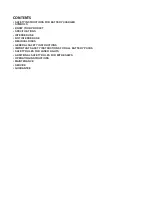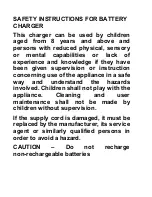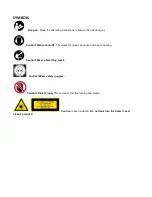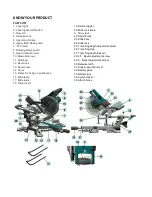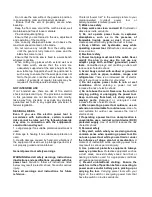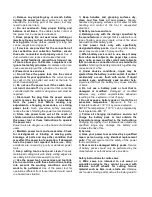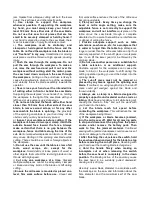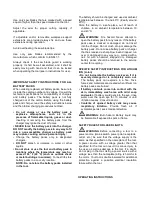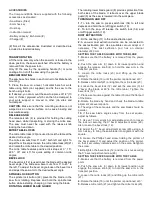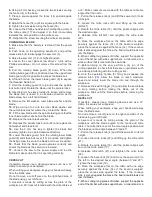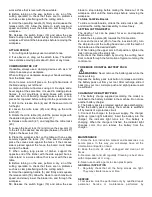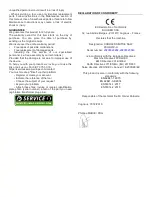
Use only saw blades that are marked with a speed
equal or higher than the speed marked on the tool.
Adjust the saw for proper cutting capacity, if
applicable.
If adjustable and/or removable workpiece support
extensions are provided always fix and use these
extensions during operation.
Avoid overheating the saw blade tips.
Use only saw blades recommended by the
manufacturer, which conform to EN 847-1.
Always check if the saw blade guard is working
properly. It shall be well assembled, and it shall be
easily moving with hand and that it can be locked
when operating the tool (see in instructions for use).
IMPORTANT SAFETY INSTRUCTIONS FOR ALL
BATTERY PACKS
When ordering replacement battery packs, be sure to
include the catalog number and voltage. Consult the
technical specifications for compatibility of chargers
and battery packs. The battery pack is not fully
charged out of the carton. Before using the battery
pack and charger, read the safety instructions below
and then follow charging procedures outlined.
• Do not charge or use the battery pack in
explosive atmospheres, such as in the
presence of flammable liquids, gases or dust.
Inserting or removing the battery pack from the
charger may ignite the dust or fumes.
• NEVER force the battery pack into the charger.
DO NOT modify the battery pack in any way to fit
into a non-compatible charger as battery pack
may rupture causing serious personal injury.
• Charge the battery packs only in designated
chargers.
• DO NOT
splash or immerse in water or other
liquids.
• Do not store or use the tool and battery pack in
locations where the temperature may reach or
exceed 104 °F (40 °C) (such as outside sheds
or metal buildings in summer).
For best life store
battery packs in a cool, dry location.
NOTE: Do not store the battery packs installed
in the tool.
The battery should be charged and used at ambient
temperatures between 10 and 40°C (ideally around
20°C).
Store the battery in a safe place, out of reach of
children, in an ambient temperature between 10
and 40°C.
WARNING:
Fire hazard. Never attempt to
open the battery pack for any reason. If the battery
pack case is cracked or damaged, do not insert
into the charger. Do not crush, drop or damage the
battery pack. Do not use a battery pack or charger
that has received a sharp blow, been dropped, run
over or damaged in any way (e.g., pierced with a
nail, hit with a hammer, stepped on). Damaged
battery packs should be returned to the service
center for recycling.
SPECIFIC SAFETY INSTRUCTIONS FOR LITHIUM
ION (Li-Ion)
• Do not incinerate the battery pack even if it is
severely damaged or is completely worn out.
The battery pack can explode in a fire. Toxic
fumes and materials are created when lithium ion
battery packs are burned.
• If battery contents come into contact with the
skin, immediately wash area with mild soap
and water.
If battery liquid gets into the eye, rinse
water over the open eye for 15 minutes or until
irritation ceases. Consult a doctor.
• Contents of opened battery cells may cause
respiratory irritation.
Provide fresh air. If
symptoms persist, seek medical attention.
WARNING:
Burn hazard. Battery liquid may
be flammable if exposed to spark or flame.
SAFETY RULES FOR LASER LIGHTS
WARNING
Before connecting a tool to a
power source (mains switch power point receptacle,
outlet, etc.) be sure that the voltage supply is the
same as that specified on the nameplate of the tool.
A power source with a voltage greater than that
specified for the tool can result in serious injury to
the user, as well as damage to the tool. If in doubt,
do not plug in the tool. Using a power source with a
voltage less than the nameplate rating is harmful to
the motor. Your tool is double insulated for additional
protection against a possible electrical insulation
failure within the tool.
OPERATING INSTRUCTIONS


